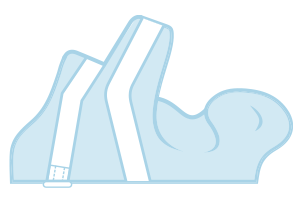Venting
Venting typically affects frequencies below 1000 Hz. In general, the larger the vent, the more low-frequency energy is 'bled off' By using different vent diameters, varying amounts of low-frequency amplification can be reduced. Earpiece venting can range from totally open or non-occluding styles to very precise and interchangeable venting via a vent control insert such as a Mini Vent Plug (MVP).
Open earpiece fittings are earpieces with very large vents. These types of earpieces can be quite effective for hearing losses that do not require low-frequency amplification. They allow the patient to perceive low-pitched sounds naturally (through the open vent), while using an instrument for high-frequency amplification. Reduction or elimination of the occlusion effect is an added benefit for the patient.
Venting Glossary
 Semi-IROS Vent
Semi-IROS Vent
The vent is cut half way from the end of the canal.
 Angle vent (AV)
Angle vent (AV)
The vent intersects the sound bore as close as possible to the tip of the canal.
 Half-External Vent
Half-External Vent
A channel from the canal tip, half way down the canal length, that transitions to an internal vent. Used when drainage or discharge from the ear is a problem.
 Parallel vent (PV)*
Parallel vent (PV)*
The sound bore and the vent travel through the earpiece side-by-side and do not intersect.
 Mini vent plugs (MVP)
Mini vent plugs (MVP)
Normally drilled with a 2.8 mm diameter bore. MVPs come with each of the following vent sizes:
#1(.100” / 2.54 mm)
#2 (.080” / 2.03 mm)
#3 (.060” / 1.52 mm)
#4 (.040” / 1.02 mm)
#5 (.030” / .76 mm)
#6 (solid plug).
 Select-A-Vent (SAV)
Select-A-Vent (SAV)
Normally drilled with a 4.5 mm diameter bore. SAVs come with each of the following vent sizes:
#1(.125” / 3.18 mm)
#2 (.110” / 2.79 mm)
#3 (.080” / 2.03 mm)
#4 (.050” / 1.27 mm)
#5 (.025” / .64 mm)
#6 (solid plug).
* Vents will be parallel as a default if no vent configuration is specified. If the physical size of the earpiece prevents use of a parallel vent, an angle vent will be used.

An Easy Way to Clean Vents
For those very small vents on hearing instruments or earpieces, try cleaning them with a dental floss loop (designed for cleaning braces and bridgework). The stiff end can be used for pressure vents. Larger vents can be cleaned by using a wax loop or pipe cleaner.
Venting Options
| Vent Size | Inches | Metric |
| Pressure | .040" | 1.0mm |
| Standard | .063" | 1.6mm |
| Medium | .081" | 2.0mm |
| Large | .096" | 2.4mm |
| MVP | (all sizes included) | (all sizes included) |
| SAV | (all sizes included) | (all sizes included) |

